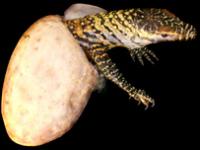







|
News and Information
'Virgin births' for giant lizards
| December 20, 2006 |
 'Virgin births' for giant lizards 'Virgin births' for giant lizards
There have been two reported cases of Komodo dragon "virgin births"
The largest lizards in the world are capable of "virgin births".
Scientists report of two cases where female Komodo dragons have produced offspring without male contact.
Tests revealed their eggs had developed without being fertilised by sperm - a process called parthenogenesis, the team wrote in the journal Nature.
One of the reptiles, Flora, a resident of Chester Zoo in the UK, is awaiting her clutch of eight eggs to hatch, with a due-date estimated around Christmas.
Kevin Buley, a curator at Chester Zoo and a co-author on the paper, said: "Flora laid her eggs at the end of May and, given the incubation period of between seven and nine months, it is possible they could hatch around Christmas - which for a 'virgin birth' would finish the story off nicely.
"We will be on the look-out for shepherds, wise men and an unusually bright star in the sky over Chester Zoo."
Flora, who has never been kept with a male Komodo dragon, produced 11 eggs earlier this year. Three died off, providing the material needed for genetic tests.
Flora had never been kept with male Komodo dragons
These revealed the offspring were not exact genetic copies (clones) of their mother, but their genetic make-up was derived just from her.
The team concluded they were a result of asexual reproduction, and are waiting for the remaining eight eggs to hatch.
Abnormal phenomenon?
Another captive-bred female called Sungai, at London Zoo in the UK, produced four offspring earlier this year - more than two years after her last contact with a male, the scientists reported in the same paper.
Again, genetic tests revealed the Komodo dragon babies, which are healthy and growing normally, were produced through parthenogenesis.
Sungai was also able to reproduce sexually, producing another baby offspring after mating with a male called Raja.
Maybe parthenogenesis is much more widespread and common than previously considered
Richard Gibson
Richard Gibson, an author on the paper and a curator at the Zoological Society of London, said: "Parthenogenesis has been described before in about 70 species of vertebrates, but it has always been regarded to be a very unusual, perhaps abnormal phenomenon."
It has been shown in some snakes, fish, a monitor lizard and even a turkey, he said.
"But we have seen this in two separate, unrelated female Komodo dragons within a year, so this suggests maybe parthenogenesis is much more widespread and common than previously considered."
He added: "Because these animals were in captivity for years without male access, they reproduced parthenogenetically.
Sungai's offspring are doing well
"But the ability to reproduce parthenogenetically is obviously an ancestral capability."
He said the lizards could have evolved the ability to reproduce asexually when, for example, a lone female was washed up alone on an island with no males to breed with.
Because of the genetics of this process, he added, her children would always be male. And like Sungai, she would be able to switch back to sexual reproduction, so she could breed to establish a new colony.
There are fewer than 4,000 Komodo dragons in the wild, and they are found in three islands in Indonesia: Komodo, Flores and Rinca.
Adult males can grow up to 3m (10ft) in length and weigh up to 90kg (200lb) - making them the biggest lizards on the planet.
The researchers said that, to ensure genetic diversity of Komodo dragons kept in captivity, zoos should perhaps keep males and females together to avoid asexual reproduction.
|
Source: www.bbc.com |
| http://news.bbc.co.uk/2/hi/science/nature/6196225.stm |
|
| Support Caprivi Freedom |
Fill out the form below to become a member of this site and receive our regular newsletter.
|

|

